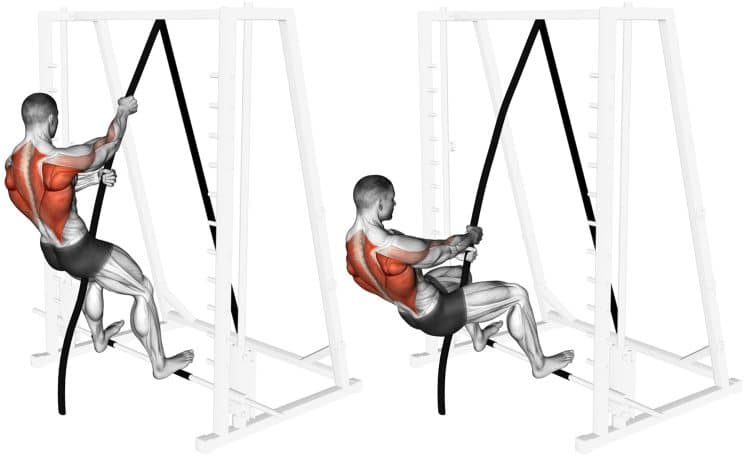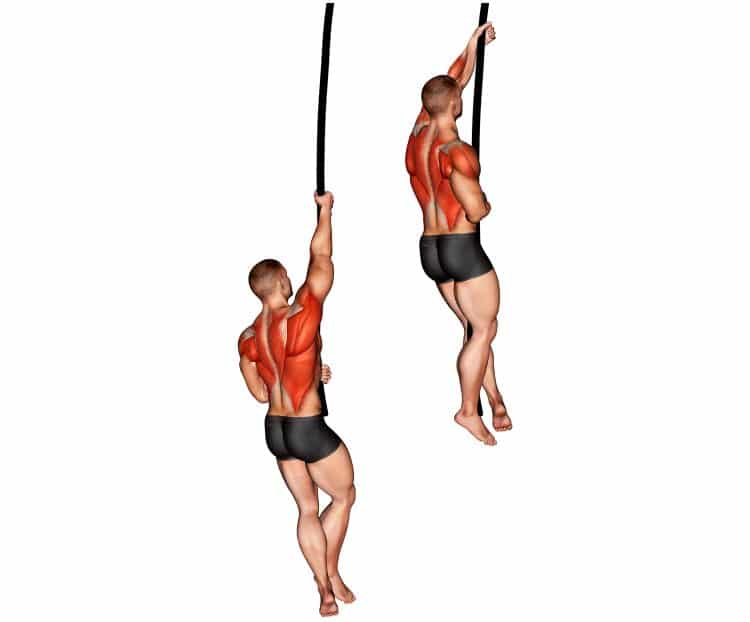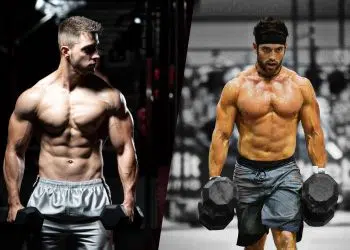Rope climbs are one of those bucket list exercises that we’ve all wanted to check off at some point. You can typically find dedicated hanging ropes for climbing at most CrossFit gyms as it’s a technique used in both local and regional competitions as well as the CrossFit Games.
Most people would be surprised to know that rope climbs involve more legs than arms and back, which is evident by how much technique goes into this fun and challenging skill-building activity.
Learn the ropes in this guide and then you should be ready to give it a try!
In This Exercise:
- Target Muscle Group: Back
- Type: Strength and function
- Mechanics: Compound
- Equipment: Hanging rope and proper attire
- Difficulty: Intermediate/advanced
How To Do Rope Climbs
Rope climbs are not an activity that most people can just walk up and do. It not only requires a strong grip and upper body strength but also proper technique to ensure a safe and efficient ascent up the rope.
Step 1: Jump and hang
The first step is pretty straightforward. You want to get a perfect jump each time to get up on the rope as high as possible.
To do it:
Level Up Your Fitness: Join our 💪 strong community in Fitness Volt Newsletter. Get daily inspiration, expert-backed workouts, nutrition tips, the latest in strength sports, and the support you need to reach your goals. Subscribe for free!
- Stand about a foot from the rope so that you can take a step toward it and gather momentum before the jump.
- Tilt your head back and look up at the rope, then step one foot toward the rope followed by the other. Your feet should be roughly shoulder width apart and your body well balanced.
- Simultaneously dip down, lean slightly forward at the hips and swing your arms back behind you. Stop when your thighs reach just above parallel to the floor. Going too far down will limit your jump ability and explosiveness.
- Now push hard off your toes and explode upward while simultaneously swinging your arms up.
- Reach as high as you can on the rope and grip it with one hand above the other.
Step 2: J-hook/clamp technique and knees to elbow
At first glance, most people may think rope climbs are mostly upper body. However, what you do with your feet is more important. In fact, if done correctly, rope climbs are more of a squat than a pull-up. The J-hook technique is considered the gold standard technique for quick and efficient rope climbs.
This technique mimics toes to bar used in CrossFit.
To do it:
- After you’ve jumped up and grabbed onto the rope, lean back and lift both of your knees up to your elbows. As you lift your knees high, slide the outside of your dominant side foot against the rope. Then bring your opposite foot under the rope and use it to wrap the rope around and over the dominant side foot. Clamp your feet tight together by using your non-dominant foot to press the rope into the side or top of your dominant foot.
Tip: The rope should be wrapped under the dominant-side foot and hanging over the other (non-dominant) foot.
Step 3: Stand up and climb
The last step is standing up out of the squat position and climbing the rope with your hands. You’ll notice that your legs do most of the work and with proper execution, you can actually let go of the rope with both hands.
- Press through your feet until your knees are fully extended and move one hand quickly over the other until you’re in a fully upright position.
Step 4: Repeat steps 1-3
After you’ve performed one rope climb, you’ll repeat the prior steps until you’ve climbed to the desired height.
Check out the video below to learn the most efficient way to rope climb explained by 2008 men’s CrossFit Games champion Jason Khalipa.
Proper Climbing Attire
If you’re serious about rope climbing or prefer to not learn the hard way, make sure that you have proper training gear. As explained in the above video, ropes and skin aren’t a good combination. A long pair of deadlift socks, protective pants or something similar will work great. We also recommend a quality pair of cross trainers with plenty of gripping power.
Related: 10 Best CrossFit shoes for women
Rope Climbing Benefits
It is a CrossFit activity but there are more reasons to try rope climbs if you have access to a proper setup.
Improve your WODs time
Most CrossFit gyms have climbing ropes as it’s a staple used in training but also as one of the events in many competitions including local tournaments to the famous CrossFit Games. If you take your training seriously then you need lots of practice and perfecting your technique and efficiency.
Build functional strength and coordination
Rope climbs involve total body strength to be able to hang from a rope, use your leg muscles to grip it tight between your feet, and stand up out of a squat all while dangling in mid air. If that’s not a functional activity then we don’t know what is. Not to mention, you need coordination and focus to do it multiple times quickly.
Incorporating multi-phase movements like rope climbs can keep you athletic and skillful.
Stronger grip
While you need a strong grip to hang from the rope, hanging from the rope will strengthen your grip. A powerful grip is an essential component of strength training because often times grip will give out before the muscles do which means you’re selling your gains short!
Burn calories
Climbing your body weight up a rope is a total body activity that requires decent effort. That means your body will be using a lot of energy and you’ll definitely get your heart rate up. With the right diet, plenty of physical activity or a good combination of both, rope climbs can contribute to your weight loss goals.
Challenge your friends
Sure the bench press will always be the standard by which most gyms bros measure and compare strength ability. But the better bencher won’t necessarily be a stronger climber. Rope climbs are something entirely different and while they do require strength, quickness is the key.
Drawbacks
There are a few obvious drawbacks to rope climbs.
Level Up Your Fitness: Join our 💪 strong community in Fitness Volt Newsletter. Get daily inspiration, expert-backed workouts, nutrition tips, the latest in strength sports, and the support you need to reach your goals. Subscribe for free!
Need a hanging rope setup
Unless you find a CrossFit gym or have your own setup then you probably won’t be doing rope climbs. The best alternative is the London bridge or something similar of which we included below as one of the best variations.
Requires a level of fitness ability
If you can’t hang from a rope or lift your knees past hip level, then forget about rope climbs. You don’t have to be a contortionist but this isn’t your basic exercise.
Can be painful without proper gear
Again, you don’t want to climb rope without wearing something to protect your legs. It can be painful when a rope repeatedly rubs against your skin.
Rope Climb Variation and Alternatives
Don’t have access to a high-hanging rope? Or maybe you want to try some different ways to scale a rope and work your pulling muscles. You should definitely try these variations and alternatives.
1. London bridge

London bridges are more realistic for most people because you can do it from a rope attached to a solid object usually a few feet higher than your head (e.g., stall bars or something similar). The difference though is London bridges are all upper body so you need good back and arm strength. Your feet remain on the floor or elevated on a raised object.
It is a good way to build your pulling strength which will help you to be able to hang your entire body weight from a rope.
2. Thick rope climb
If standard sized rope climbs have been too easy, attach a thicker rope for a greater grip challenge. You may find that your forearms tire a little faster but you’ll definitely get stronger. Additionally, because the rope is thicker and stronger, it’s probably going to be more rigid which means better supports when you wrap it around your feet.
3. L-climbs
If you’re an abs workout aficionado and are able to do climb a rope without the use of your feet, then you ought to like this rope climb variation. You do need flexibility, mobility and strength in your hips as well as a solid midsection too.
The goal is to keep your feet together and legs parallel to the floor as you climb up the rope using just your arms.
4. Rope pull-ups
Rope climbs involve the pull-up to a smaller degree because the legs do most of the heavy lifting. But you can also just perform pull-ups on the rope to work your back, biceps and forearms muscles.
- Jump up and grab the rope with one hand above the other and perform pull-ups as normal.
Check out these 11 awesome rope climb variations, some of which we included above.
Muscles Worked
There’s not a muscle in your body that’s left out during rope climbs.

Infraspinatus – The infraspinatus is a rotator cuff muscle like the supraspinatus, teres minor, and subscapularis. Collectively, they provide stability to the glenohumeral or shoulder joint. Infraspinatus is responsible for external rotation of the shoulder joint, scaption, and lateral rotation of the humerus. [1]
Latissimus Dorsi – The latissimus dorsi or lats is a large muscle in the back that, when developed can look like bat wings when flexed. It along with the teres major and pectoralis major adduct and medially rotate the humerus, and contribute to other functions. [2] When the arms are placed overhead the lats help to move the trunk forward and upward.
Teres Major – The teres major is a thick muscle in the shoulder joint that medially rotates and adducts (pulls arms in toward center of the body) the arm and stabilizes the shoulder joint. However, unlike the teres minor, it’s not one of the rotator cuff muscles.
Teres Minor – The teres minor is a rotator cuff muscle that assists the other rotators in stabilizing the glenohumeral joint. Although it specifically contributes to lateral, or external rotation of the arm at the shoulder.
Trapezius Lower Fibers – One of the three sections of trapezius muscle fibers, the lower traps allow us to pull the scapula down but it also helps the upper fibers to lift the scapula. [3]
Trapezius Middle and Upper Fibers – The middle section of trapezius fibers pulls the shoulders blades back while the upper fibers elevate the scapula. The traps muscles are a visually impressive muscle group and one associated with bodybuilders.
Brachialis – It’s a muscle most of us cannot see but the brachialis is a pure elbow flexor located beneath the outer biceps. It’s typically targeted with hammer grip curls but any pulling movement (e.g., rope climbs) will activate this muscle. Brachialis can make the upper arms wider if you have good arm genetics. [4]
Brachioradialis – An underrated muscle, the brachioradialis is located in the lateral forearms and the good news is with enough curls and pulling exercises you can build it to an impressive size. This muscle is an elbow flexor but it also pronates and supinates the forearms.
Bottom Line
Whether you’re competing in a CrossFit event or you just like the challenge that comes with rope climbs, we can vouch for the versatility of this functional and fun activity. It’s not for everyone as you do need to be decently strong overall, however, the technique can be easy to learn with practice and doing progressions, and many find it to be very rewarding too. Plus, there are many beneficial variations that we included in this in-depth guide.
References:
- Williams, J. M., Sinkler, M. A., & Obremskey, W. (2021, August 13). Anatomy, Shoulder and Upper Limb, Infraspinatus Muscle – StatPearls – NCBI Bookshelf. Anatomy, Shoulder and Upper Limb, Infraspinatus Muscle – StatPearls – NCBI Bookshelf.
- Jeno, S. H., & Varacallo, M. (2022, April 5). Anatomy, Back, Latissimus Dorsi – StatPearls – NCBI Bookshelf. Anatomy, Back, Latissimus Dorsi – StatPearls – NCBI Bookshelf.
- Ourieff, J., Scheckel, B., & Agarwal, A. (2021, July 26). Anatomy, Back, Trapezius – StatPearls – NCBI Bookshelf. Anatomy, Back, Trapezius – StatPearls – NCBI Bookshelf.
- Plantz, M. A., & Bordoni, B. (2022, February 22). Anatomy, Shoulder and Upper Limb, Brachialis Muscle – StatPearls – NCBI Bookshelf. Anatomy, Shoulder and Upper Limb, Brachialis Muscle – StatPearls – NCBI Bookshelf.
Interested in measuring your progress? Check out our strength standards for Bench Press, Pull Ups, Deadlift, and more.











